Experience Tumblr like never before
Bathypelagic Zone - Blog Posts


Gulper Eel
Saccopharynx sp.
The Gulper Eel is known for its massive jaws, which are capable of swallowing prey whole. It’s stomach is also able to expand twice its size. It is found only in the deep see about 2000 to 3000 meters in depth.
Photo credit: https://www.youtube.com/watch?v=XRO0IjSoHGA
https://marinebiochemistrygc2018.weebly.com/deep-sea-adaptations

Glasshead Grenadier
Hymenocephalus italicus
The Glasshead Grenadier is a small deep sea fish named due to a transparent memberane that covers its head. It has fragile head bones, and it feeds on surface copepods and crustaceans. This fish is located between 100 m to 2000 m in the ocean.
Photo credit: https://www.fishbase.se/summary/1720
https://www.futura-sciences.com/planete/photos/oceanographie-abysses-ces-merveilles-profondeurs-40-photos-686/ocean-grenadier-vitrier-hymenocephalus-italicus-poisson-abysses-4541/
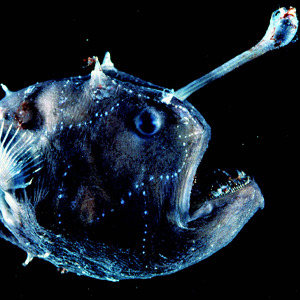

Football Fish
Himantolophus paucifilosus
The Football fish is a deep sea angular fish located between 1000 to 4000 meters in the ocean. The glowing dots on its body are sensory organs called neuromast that help the fish detect changes in the water.
Photo credit: https://alchetron.com/Footballfish
https://www.amazon.com/Creatures-Deep-Search-Monsters-World/dp/1770852816

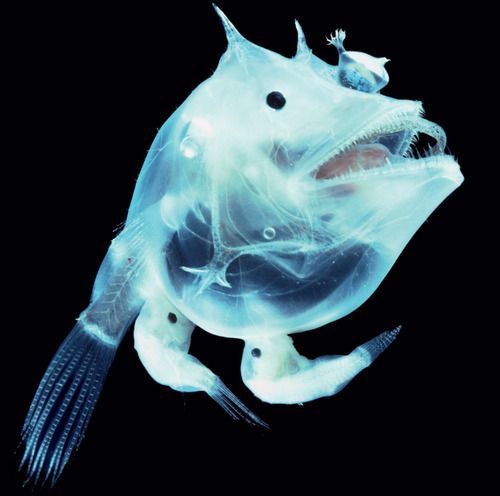
Deep-sea white anglerfish
Haplophryne mollis
The Deep-sea white anglerfish is a ghostly white creature found at depths between 1000m to 4000m. The strange bulge between its eyes is a bioluminescent lure. The main fish above is a female and the tiny fish attached to her body are males. Since it is difficult to find mates in the deep ocean, male fish latch onto the female with hooked teeth. Even though the male fish are parasitic, they are eventually reduced to pockets of sperm that are used for reproduction. For all you fellas out there that have a rough time with the ladies, be thankful that you are at least not a bag of gonads floating through the ocean.
Photo credit: https://www.pinterest.co.uk/pin/440297301041956897/
https://news.cgtn.com/news/3d3d414d3559444f7a457a6333566d54/share_p.html

Threadfin Snailfish
Careproctus longifilis
The Threadfin Snailfish resembles a prehistoric tadpole that is ghostly white. The holes in its face are large sensory pores that help them detect changes in the ocean. It is often found at depths between 1900 to 2997 meters.
Photo credit: https://www.timeout.com/singapore/museums/creatures-of-the-deep



Black Dragonfish
Idiacanthus atlanticus
The Black Dragonfish are needle-like fish that migrate between 500m and 2000m in the deep ocean. Females are black with 6 stripes and lack a barbel, pelvic fins, and sharp teeth. Males, on the other hand, are dark brown and have a barbel, which is the light producing structure on its chin. Furthermore, it uses bioluminescence to detect prey instead of lure prey.
Photo credit: https://scitechdaily.com/scientists-learn-secrets-from-ultra-black-skin-that-allows-deep-sea-fish-to-lurk-unseen/
https://steemit.com/life/@munnashah/the-most-terrible-and-surprising-7-animals-of-the-sea
https://knowyourmeme.com/photos/995601-thalassophobia


Wolftrap Angler
Thaumatichthys binghami
The Wolftrap Angler is slightly different from many other species of anglers. It has its bioluminescent lure located inside of its mouth instead of connected to its body. Even though it is intimidating up close, it is only nine centimeters in size. It is found in the deep ocean at 2432m.
Photo credit
https://en.wikipedia.org/wiki/Thaumatichthys_binghami
https://igniteyourcuriosity.wordpress.com/2016/10/22/anglerfish/


Silky Medusa
Colobonema sericeum
The Silky Medusa is a gentle and reserved jellyfish; it has white-tipped tentacles that have the ability to detach from its body and bioluminescence when attacked by predators. It can be found drifting between 500 m to 1500 m. Furthermore, it consumes small crustaceans.
Photo credit: https://twitter.com/mbari_news/status/949736123760340994
https://www.montereybayaquarium.org/animals/animals-a-to-z/midwater-jelly
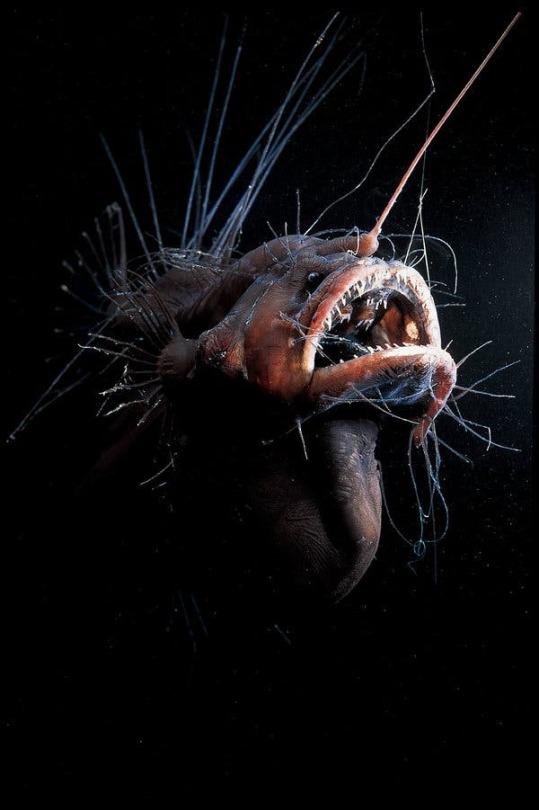
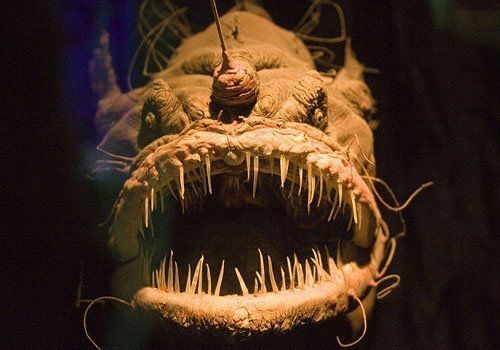
Fanfin Seadevil
Caulophyyne jordani
The Fanfin Seadevil is an ugly, deep fish that is covered in gnarled skin and long sensory filaments. The sensory filaments allow this species of anglerfish to detect movement in the water; this helps the Fanfin find and lure its prey. Furthermore, this deformed monstrosity can be found floating between 700m to 3000m in the ocean.
Photo credit: https://www.nytimes.com/2019/07/29/science/anglerfish-bioluminescence-deep-sea.html
http://www.robotspacebrain.com/alien-creatures-of-the-mariana-trench/


Mid-water Arctic Hydrozoan
Botrynema brucei
The Mid-water Arctic Hydrozoan is a mini-jelly that is transparent with hints of blue. It thrives in freezing cold temperatures and drifts aimlessly in the Artic Ocean. Moreover, it is only 3 cm in size and floats between 900m to 2,600m.
Photo credit: https://en.wikipedia.org/wiki/Botrynema_brucei
http://www.arcodiv.org/watercolumn/cnidarian/Botrynema_brucei.html
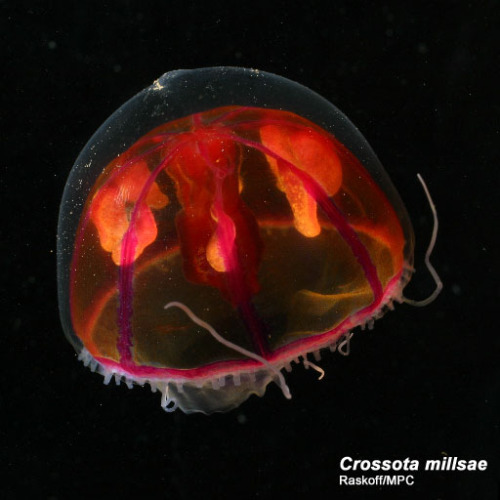
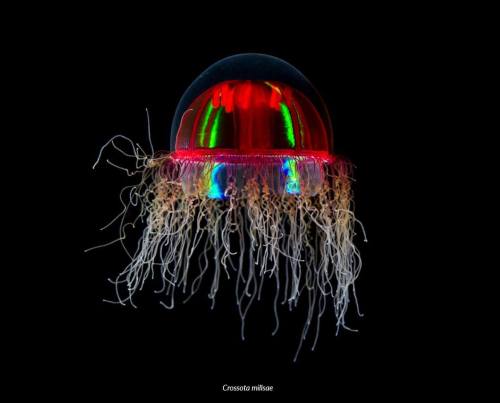
Psychedelic Medusa
Crossota millsae
The Psychedelic Medusa is a deep-sea hydrozoan that is abundant in the North Pacific. The mini-jelly is found at depths between 1000m to 3800m, and are often observed drifting near the ocean floor. It also has an eccentric reproduction behavior uncommon in cnidarians. The females display viviparity, and carry the babies in her bell until they are ready to hatch.
Photo credit: http://www.arcodiv.org/watercolumn/cnidarian/Crossota_millsae.html
https://twitter.com/spothvegr/status/1030177493075079169


Atolla Jelly
Atolla wyvillei
The Atolla Jelly is a fiery, red jellyfish that has an extraordinary display of bioluminescence. When the jelly is attacked, it uses bioluminescence to produce thousands of vibrant, blue flashes; the blue flashes act as an alarm, which draws in bigger predators and warns prey. The jelly can be found at depths between 600 m to 1500m, and it also has a long hypertrophied tentacle that aids in reproduction.
Photo credit: https://en.wikipedia.org/wiki/Atolla_jellyfish
https://en.wikipedia.org/wiki/Atolla_jellyfish

Black Medusa
Vampyrocrossota childressi
The Black Medusa is an inky, black hydrozoan that absorbs all light that hits its tiny body. It has a translucent gelatin and a black umbrella; it is also only 1.5 cm in size. Moreover, it is found at depths between 600m to 1500m, and it spends its entire life floating in the deep ocean.
Photo credit: https://www.pinterest.com/pin/488148047080475827/


Googly-eyed glass squid
Teuthowenia pellucida
The Googly eyed squid is a rare oddity that is found in the southern hemisphere. It has a large, spherical head that is filled with water and teeny, tiny tentacles that help propel it through the water. If it comes across a predator, it deflates its head and draws its tentacles into its cavity. On the other hand, it may also fill the cavity with water to increase its size, and intimidate the predator. If all fails, it will ink and try to escape through the darkness. Furthermore, baby squids can be found at the surface (0-600m); then slowly migrate downwards as they mature into adults (1600-2500m).
Photo credit: http://animaladay.blogspot.com/2011/07/googly-eyed-glass-squid.html
https://faunafabula.tumblr.com/post/5999675353/googly-eyed-glass-squid-teuthowenia-pellucida


Piglet Squid
Helicocranchia pfefferi
The Piglet Squid is a very small and delicate, transparent squid. It is found at depths between 400 to 1000 m. It has an unique siphon that is used for jet propulsion and it resembles a pig muzzle. The young piglet squids tend to live close to the surface, and steadily migrates downward as they grow. This behavior is called ontogenetic migration.
Photo credit: http://photo.cctv.com/2019/07/23/PHOAKMEBh8xJRaHXEUIGx8kE190723.xml
https://www.ourbreathingplanet.com/banded-piglet-squid/

Glass Octopus
Vitreledonella richardi
The Glass Octopus spend its entire life in the midwater section of the ocean and found at depths between 200m to 2000m. Even though it has no protection from predators, it achieves perfect transparency. The only part of the Glass Octopus that is visible is its digestive gland. However, the digestive gland is placed vertically to minimize detection. In addition, I find this octopus to be super cute!
Photo credit: https://www.mynumer.com/forums/topic/499/invisible-animals/view/post_id/859


Cockatoo Squid
Galiteuthis phyllura
The Cockatoo squid is a highly-specialized oddity of the deep ocean and found at depths between 300 to 1400 m. It is completely transparent, except for its eyes. It also has bioluminescent photophores that are directed downward: this makes it difficult for deep sea predators to see the Cockatoo Squid. It was named after the Cockatoo because it holds its tentacles above its head, resembling the bird. The Cockatoo squid can also get fairly large with adults reaching lengths of 2.7 meters (over 6 ft.)
Photocredit: https://www.americanscientist.org/article/at-home-in-the-dark
https://www.pinterest.com/pin/28710516347382519/

Vampire Squid
Vampyroteuthis infernalis
Even though the Vampire Squid is named after a notorious monster, this gentle creature does not live up to its name. It is only a foot long and occupies depths between 650m to 1500m in the deep ocean. Unlike other squids, it has reduced musculature and collects particles in the water column. However, it is capable of huge bursts of speeds. It uses bioluminescence to confuse both predators.
Photo credit: https://ocean.si.edu/ocean-life/invertebrates/vampire-squid-hell

Sea Angel
Cliopsis krohni
The Sea Angel is a tiny snail that is only 4 cm in length and found at depths as deep as 1500 m. Even though it is small, it is a viscous predator. It hunts other midwater snails using a structure called a radula. Unlike other snails, the Sea Angel’s mouth is located on top of its head. It also uses swimming “wings” to propel through the water.
Photo Source: http://seaslugsofhawaii.com/species/Cliopsis-krohni-a.html


Spookfish
Winteria telescopa
The Spookfish’s eyes act as a telescope and are designed to maximize light in the deep ocean. Its eyes contain rod cells that help distinguish between ambient light and bioluminescent light. This adaptation helps avoid predators and catch prey.
Picture Credit: https://www.natureplprints.com/deep-sea/deep-sea-fish-winteria-telescopa-15230734.html